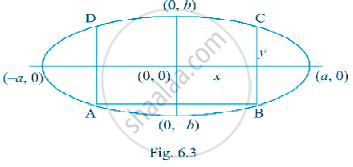Advertisements
Advertisements
प्रश्न
Find the area of greatest rectangle that can be inscribed in an ellipse `x^2/"a"^2 + y^2/"b"^2` = 1
उत्तर

Let ABCD be the rectangle of maximum area with sides AB = 2x and BC = 2y
Where C (x, y) is a point on the ellipse `x^2/"a"^2 + y^2/"b"^2` = 1 as shown in the Fig.6.3.
The area A of the rectangle is 4xy
i.e. A = 4xy which gives A2 = 16x2y2 = s ....(say)
Therefore, s = `16x^2 (1 - x^2/"a"^2)*"b"^2`
= `(16"b"^2)/"a"^2 ("a"^2x^2 - x^4)`
⇒ `"ds"/"dx" = (16"b"^2)/"a"^2 * [2"a"^2x - 4x^3]`
Again, `"ds"/"dx"` = 0
⇒ x = `"a"/sqrt(2)` nad y = `"b"/sqrt(2)`
Now, `("d"^2"s")/("dx"^2) = (16"b"^2)/"a"^2 [2"a"^2 - 12x^2]`
At x = `"a"/sqrt(2), ("d"^2"s")/("dx"^2)`
= `(16"b"^2)/"a"^2 [2"a"^2 - 6"a"^2]`
= `(16"b"^2)/"a"62 (-4"a"^2) < 0`
Thus at x = `"a"/sqrt(2)`, y = `"b"/sqrt(2)`
s is maximum and hence the area A is maximum.
Maximum area = 4.x.y
= `4 * "a"/sqrt(2) * "b"/sqrt(2)`
= 2ab sq units.
APPEARS IN
संबंधित प्रश्न
A cone is inscribed in a sphere of radius 12 cm. If the volume of the cone is maximum, find its height
f(x) = 3 + (x − 2)2/3 on [1, 3] Discuss the applicability of Rolle's theorem for the following function on the indicated intervals ?
f (x) = [x] for −1 ≤ x ≤ 1, where [x] denotes the greatest integer not exceeding x Discuss the applicability of Rolle's theorem for the following function on the indicated intervals ?
\[f\left( x \right) = \begin{cases}- 4x + 5, & 0 \leq x \leq 1 \\ 2x - 3, & 1 < x \leq 2\end{cases}\] Discuss the applicability of Rolle's theorem for the following function on the indicated intervals ?
Verify Rolle's theorem for the following function on the indicated interval f (x) = (x − 1) (x − 2)2 on [1, 2] ?
Verify Rolle's theorem for the following function on the indicated interval f (x) = x(x − 1)2 on [0, 1] ?
Verify Rolle's theorem for the following function on the indicated interval f(x) = 2 sin x + sin 2x on [0, π] ?
Verify Rolle's theorem for the following function on the indicated interval \[f\left( x \right) = \frac{6x}{\pi} - 4 \sin^2 x \text { on } [0, \pi/6]\] ?
Verify Rolle's theorem for the following function on the indicated interval f(x) = x2 − 5x + 4 on [1, 4] ?
At what point on the following curve, is the tangent parallel to x-axis y = \[e^{1 - x^2}\] on [−1, 1] ?
Verify Lagrange's mean value theorem for the following function on the indicated intervals. find a point 'c' in the indicated interval as stated by the Lagrange's mean value theorem f(x) = 2x − x2 on [0, 1] ?
Verify Lagrange's mean value theorem for the following function on the indicated intervals. find a point 'c' in the indicated interval as stated by the Lagrange's mean value theore f(x) = (x − 1)(x − 2)(x − 3) on [0, 4] ?
Verify Lagrange's mean value theorem for the following function on the indicated intervals. find a point 'c' in the indicated interval as stated by the Lagrange's mean value theore f(x) = tan−1 x on [0, 1] ?
Verify Lagrange's mean value theorem for the following function on the indicated intervals. find a point 'c' in the indicated interval as stated by the Lagrange's mean value theorem f(x) = x2 + x − 1 on [0, 4] ?
Verify Lagrange's mean value theorem for the following function on the indicated intervals. find a point 'c' in the indicated interval as stated by the Lagrange's mean value theorem f(x) = sin x − sin 2x − x on [0, π] ?
Discuss the applicability of Lagrange's mean value theorem for the function
f(x) = | x | on [−1, 1] ?
Using Lagrange's mean value theorem, prove that (b − a) sec2 a < tan b − tan a < (b − a) sec2 b
where 0 < a < b < \[\frac{\pi}{2}\] ?
For the function f (x) = x + \[\frac{1}{x}\] ∈ [1, 3], the value of c for the Lagrange's mean value theorem is
The value of c in Rolle's theorem when
f (x) = 2x3 − 5x2 − 4x + 3, x ∈ [1/3, 3] is
If f (x) = ex sin x in [0, π], then c in Rolle's theorem is
Find the points on the curve x2 + y2 − 2x − 3 = 0 at which the tangents are parallel to the x-axis ?
A wire of length 50 m is cut into two pieces. One piece of the wire is bent in the shape of a square and the other in the shape of a circle. What should be the length of each piece so that the combined area of the two is minimum?
Show that height of the cylinder of greatest volume which can be inscribed in a right circular cone of height h and semi-vertical angle α is one-third that of the cone and the greatest volume of the cylinder is `(4)/(27) pi"h"^3 tan^2 α`.
An isosceles triangle of vertical angle 2θ is inscribed in a circle of radius a. Show that the area of triangle is maximum when θ = `pi/6`
Minimum value of f if f(x) = sinx in `[(-pi)/2, pi/2]` is ______.
At what point, the slope of the curve y = – x3 + 3x2 + 9x – 27 is maximum? Also find the maximum slope.
Prove that f(x) = sinx + `sqrt(3)` cosx has maximum value at x = `pi/6`
Let y = `f(x)` be the equation of a curve. Then the equation of tangent at (xo, yo) is :-
